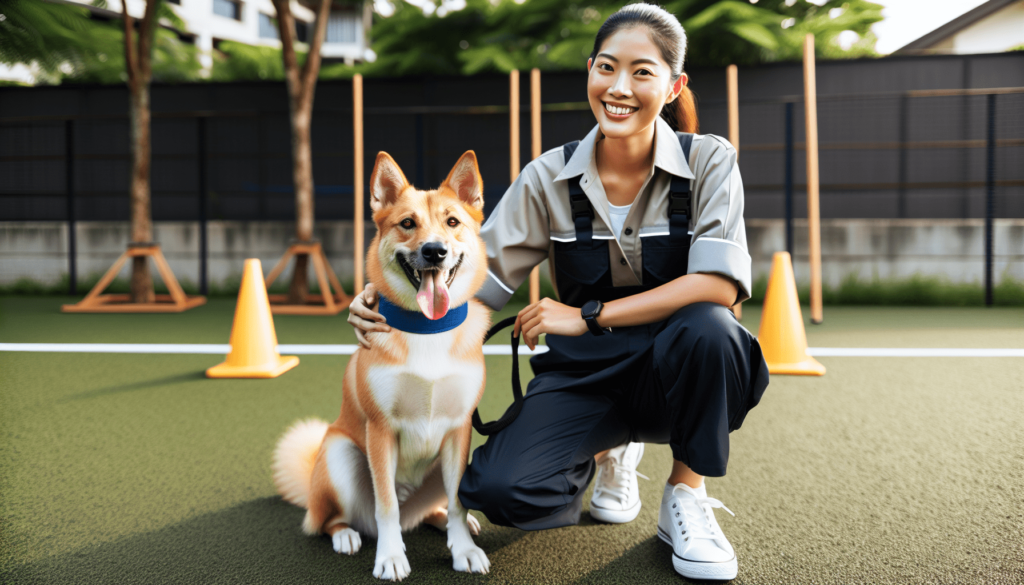Finding the perfect dog trainer can be a daunting task, but fear not, because we’ve got you covered. In this article, you will discover invaluable tips and tricks to help you choose the right dog trainer for your furry friend. From qualifications to training methods, we’ll guide you through the process, ensuring that you make the best choice for your beloved canine companion. So, let’s embark on this journey together and find the perfect trainer that will help unlock your dog’s full potential.
1. Determine Your Training Goals
When it comes to choosing the right dog trainer, the first step is to determine your training goals. Consider what specific behaviors you want to address with your dog. Is it obedience training, leash walking, or overcoming certain behavioral issues? By identifying the areas you would like to focus on, you can find a trainer who specializes in those particular areas.
It’s also important to think about your long-term goals for your dog’s training. Do you want your furry friend to become a well-behaved companion or perhaps a therapy dog? Understanding your long-term objectives will help you find a trainer who can guide both you and your dog towards success.
2. Research Different Training Methods
With a plethora of training methods available, it’s crucial to research and understand the various techniques before choosing a dog trainer. Positive reinforcement is a popular and effective training method that focuses on rewarding your dog for desired behaviors. This method helps foster a strong bond between you and your furry friend while motivating them to repeat the behavior. On the other hand, aversive training methods utilize punishment or negative reinforcement to discourage unwanted behaviors. It’s important to consider your own values and beliefs when selecting a training method.

3. Look for Qualified and Certified Trainers
When it comes to entrusting your dog’s training to someone else, it’s essential to find a qualified and certified trainer. Check for certifications and credentials that demonstrate the trainer’s expertise and knowledge in canine behavior and training techniques. Look for trainers who have completed courses or obtained certifications from reputable organizations such as the Certification Council for Professional Dog Trainers (CCPDT) or the Association of Professional Dog Trainers (APDT).
Additionally, ensure that the trainer has experience with your dog’s breed or any specific behavioral issues your dog may have. Different breeds may require different training approaches, so finding a trainer who understands the specific needs of your dog’s breed can be beneficial.
4. Read Online Reviews and Testimonials
One of the most valuable resources when choosing a dog trainer is online reviews and testimonials from previous clients. Search for reviews on websites or social media platforms to gather insight into others’ experiences with a particular trainer. Pay close attention to any recurring positive or negative feedback to get a better understanding of the trainer’s strengths and weaknesses. However, keep in mind that every dog is unique, so while reviews can provide helpful insights, personal interactions and observations should play a significant role in your decision-making process.

5. Visit Training Facilities
Before making a final decision, it’s advisable to visit the training facility in person. This will give you a firsthand experience of the environment your dog will be trained in. During your visit, pay attention to the cleanliness and organization of the facility. A clean and well-maintained facility reflects the trainer’s professionalism and dedication to creating a safe and comfortable learning environment for the dogs.
Additionally, observe how the trainers interact with the dogs in the facility. Do they exhibit patience, kindness, and effective communication with the animals? These observations can give you a sense of the trainer’s training style and how they handle the dogs under their care.
6. Attend Training Sessions or Classes
Consider attending a training session or class as an observer before committing to a particular trainer. This will allow you to see the trainer in action and evaluate their teaching style. Pay attention to how the trainer interacts with the dogs. Do they use positive reinforcement techniques and reward-based training? Do they provide clear instructions and guidance? Assessing these factors will help you determine if the trainer’s teaching style aligns with your own preferences and goals for your dog’s training.
7. Evaluate the Trainer’s Communication Skills
Effective communication between the trainer, you, and your dog is vital for successful training. During your interactions with the trainer, assess their ability to communicate effectively. Do they listen attentively to your concerns and questions? Are their explanations clear and easy to understand? A trainer who can effectively communicate with you will ensure that you fully grasp the training techniques and methods, enabling you to continue reinforcing the training at home.
Furthermore, observe how the trainer communicates with your dog. Do they establish a positive connection and build trust? A trainer who can communicate and connect with your dog can create a harmonious learning environment and facilitate faster progress in training.
8. Inquire About Training Techniques
Once you have found a trainer who aligns with your training goals and communicates effectively, it’s important to inquire about their preferred training techniques. Discuss the methods they use to address specific behaviors or challenges. Make sure their techniques resonate with your personal beliefs and values as a dog owner. Avoid trainers who rely heavily on punitive or aversive training methods, as they can potentially harm the emotional well-being of your dog.
Remember, positive reinforcement techniques that reward and motivate your dog tend to yield better long-term results while strengthening the bond between you and your furry companion.
9. Discuss Training Plans and Expectations
Before committing to a trainer, have a thorough conversation about their training plans and strategies. Discuss the steps involved in the training process, the expected duration, and any potential challenges along the way. It’s important to clarify your expectations and goals for the training process, ensuring that both you and the trainer are on the same page.
During this discussion, the trainer should provide insights into how they will tailor the training to your dog’s specific needs. A personalized training plan that considers your dog’s individuality, temperament, and behavioral issues will enhance the likelihood of success.
10. Trust Your Instincts and Gut Feeling
Ultimately, when choosing a dog trainer, it’s crucial to trust your instincts and gut feeling. Your intuition can often guide you towards the right decision. After considering all the factors mentioned above, listen to your inner voice and ask yourself if you feel comfortable and confident with the trainer. Remember, the training process requires collaboration and trust between you, the trainer, and your dog. Choosing a trainer whom you connect with on a personal level will make the journey more enjoyable and rewarding.
In conclusion, choosing the right dog trainer requires careful consideration and research. By determining your training goals, researching different methods, seeking qualified trainers, reading reviews, visiting training facilities, observing training sessions, evaluating communication skills, inquiring about training techniques, discussing plans and expectations, and trusting your instincts, you can find a trainer who will guide you and your furry companion towards success in training and strengthening your bond. Happy training!

